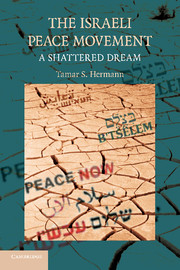Book contents
- Frontmatter
- Contents
- Acknowledgments
- 1 Introduction
- 2 Exploring Peace Activism – A Road Map
- 3 Mapping the Israeli Sociopolitical Terrain
- 4 Paving the Road to Oslo – Israeli Peace Activism through 1993
- 5 The Path Strewn with Obstacles (1993–2008)
- 6 A Path Finder – Exploring New Ways or Getting Lost?
- Appendix 1 List of Israeli Peace Groups
- Appendix 2 Israeli Jewish Public Opinion on the Oslo Process (1994–2008)
- Bibliography
- Index
2 - Exploring Peace Activism – A Road Map
Published online by Cambridge University Press: 08 January 2010
- Frontmatter
- Contents
- Acknowledgments
- 1 Introduction
- 2 Exploring Peace Activism – A Road Map
- 3 Mapping the Israeli Sociopolitical Terrain
- 4 Paving the Road to Oslo – Israeli Peace Activism through 1993
- 5 The Path Strewn with Obstacles (1993–2008)
- 6 A Path Finder – Exploring New Ways or Getting Lost?
- Appendix 1 List of Israeli Peace Groups
- Appendix 2 Israeli Jewish Public Opinion on the Oslo Process (1994–2008)
- Bibliography
- Index
Summary
The story of the Israeli peace movement in the Oslo era is agonizing yet fascinating. After all, rarely does a small and poorly resourced social movement face a situation in which some of the main pillars of its agenda that were formerly widely rejected are suddenly integrated into formal national policy. However, this is exactly what occurred when the Rabin government, elected in 1992, presented its blueprint for peace and launched the Oslo process a year later. When this happened, the peace movement was presented with at least three dilemmas: first, it had to choose between the normal organizational (and human) tendency to claim “copyrights” – in this case for the political breakthrough that Oslo embodied – and the realization that the less it is associated with this strategic shift, the better the chances that the process would gain wide public support. Second, the government takeover of the peace agenda raised questions about the movement's raison d'être. The second dilemma therefore became, should the peace movement dissolve itself or search for a new set of aims? Third, once the decision was made to continue its activity, the movement had to redefine its relations with the political establishment and the mainstream, because for the first time in its history, it found itself in concert, in principle at least, with decision makers and large public sectors and not on the side of the opposition. This change called for a basic transformation of the movement's state of mind.
- Type
- Chapter
- Information
- The Israeli Peace MovementA Shattered Dream, pp. 12 - 44Publisher: Cambridge University PressPrint publication year: 2009

